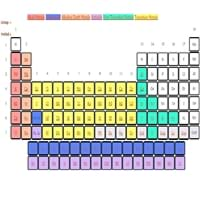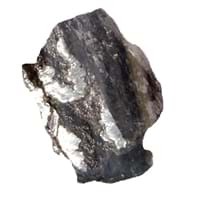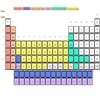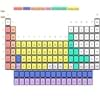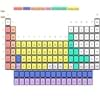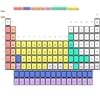Rutherfordium vs Lanthanum
Periodic Table
Symbol
Rf
La
Group Number
4
14
Not Available
Period Number
7
6
Block
d block
f block
Element Family
Transition Metal
Lanthanide
CAS Number
53850365
13
7439910
99+
Space Group Name
Not Available
P63/mmc
Space Group Number
Not Available
194.00
5
Facts
Interesting Facts
- Rutherfordium does not occur in nature as it is a synthetic element.
- Till date Rutherfordium metal has 15 radioisotopes created synthetically.
- Lanthanum metal is highly malleable, ductile and sectile.
- If exposed to air Lanthanum metal oxidizes rapidly.
Sources
Bombarding Plutonium with Accelerated 113 to 115 MeV Neon Ions, Synthetically Produced
Found in Minerals, Mining, Ores of Minerals
History
Who Discovered
Joint Institute for Nuclear Research
Carl Gustaf Mosander
Discovery
In 1964
In 1838
Abundance
Abundance In Universe
Not Available
2 * 10-7 %
22
Abundance In Sun
~-9999 %
~0.0000002 %
25
Abundance In Meteorites
Not Available
0.00 %
32
Abundance In Earth's Crust
Not Available
0.00 %
19
Abundance In Oceans
Not Available
0.00 %
29
Uses
Uses & Benefits
- Currently known uses of Rutherfordium metal are limited to research purpose only.
- It has no commercial uses, but its alloys are in high demand. Lanthanum and Nickel alloy is used for the hydrogen gas storage.
- The best-known use for mischmetal alloy of Lanthanum is; as a ‘flints’ for cigarette lighters.
Industrial Uses
NA
Electrical Industry, Electronic Industry
Medical Uses
NA
NA
Other Uses
Alloys, Research Purposes
Alloys, Mirror Manufacturing
Biological Properties
Toxicity
Unknown
Low Toxic
Present in Human Body
No
Yes
In Blood
0.00 Blood/mg dm-3
37
Not Available
In Bone
0.00 p.p.m.
36
0.08 p.p.m.
24
Physical Properties
Melting Point
2,100.00 °C
11
920.00 °C
99+
Boiling Point
5,500.00 °C
3
3,469.00 °C
18
Appearance
Physical State
Solid
Solid
Color
Unknown
Silvery White
Luster
Unknown Luster
NA
Hardness
Mohs Hardness
Not Available
2.50
14
Brinell Hardness
Not Available
350.00 MPa
30
Vickers Hardness
Not Available
360.00 MPa
26
Speed of Sound
Not Available
2,475.00 m/s
37
Optical Properties
Allotropes
No
No
α Allotropes
Not Available
Not Available
β Allotropes
Not Available
Not Available
γ Allotropes
Not Available
Not Available
Chemical Properties
Chemical Formula
Rf
La
Isotopes
Known Isotopes
13
26
31
8
Electronegativity
Pauling Electronegativity
Not Available
1.10
99+
Allred Rochow Electronegativity
Not Available
1.08
31
Electropositivity
Pauling Electropositivity
Not Available
2.90
10
Ionization Energies
1st Energy Level
579.90 kJ/mol
99+
538.10 kJ/mol
99+
2nd Energy Level
1,389.40 kJ/mol
99+
1,067.00 kJ/mol
99+
3rd Energy Level
2,296.40 kJ/mol
99+
1,850.30 kJ/mol
99+
4th Energy Level
3,077.90 kJ/mol
99+
4,819.00 kJ/mol
22
5th Energy Level
Not Available
5,940.00 kJ/mol
25
Electrochemical Equivalent
Not Available
1.73 g/amp-hr
99+
Electron Work Function
Not Available
3.50 eV
31
Other Chemical Properties
Ionization, Radioactive Isotopes, Radioactivity
Ionization, Radioactive Isotopes, Solubility
Atomic Properties
Atomic Number
104
14
57
99+
Electron Configuration
[Rn] 5f14 6d2 7s2
[Xe] 5d2 6s2
Crystal Structure
Hexagonal Close Packed (HCP)
Double Hexagonal Close Packed (DHCP)
Crystal Lattice
BCC-Crystal-Structure-.jpg#100
DHCP-Crystal-Structure-of-Lanthanum.jpg#100
Atom
Number of Protons
104
14
57
99+
Number of Neutrons
157
7
82
99+
Number of Electrons
104
14
57
99+
Radius of an Atom
Atomic Radius
150.00 pm
33
187.00 pm
8
Covalent Radius
157.00 pm
31
207.00 pm
6
Van der Waals Radius
Not Available
240.00 pm
13
Atomic Weight
267.00 amu
11
138.91 amu
99+
Atomic Volume
Not Available
20.73 cm3/mol
16
Adjacent Atomic Numbers
Valence Electron Potential
Not Available
40.71 (-eV)
99+
Lattice Constant
Not Available
377.20 pm
28
Lattice Angles
NA
π/2, π/2, 2 π/3
Lattice C/A Ratio
Not Available
1.62
2
Mechanical Properties
Density
Density At Room Temperature
23.20 g/cm3
8
6.16 g/cm3
99+
Density When Liquid (at m.p.)
Not Available
5.94 g/cm3
99+
Tensile Strength
Not Available
Not Available
Viscosity
Not Available
Not Available
Vapor Pressure
Vapor Pressure at 2000 K
Not Available
0.98 (Pa)
15
Elasticity properties
Shear Modulus
Not Available
14.30 GPa
40
Bulk Modulus
Not Available
27.90 GPa
99+
Young's Modulus
Not Available
36.60 GPa
99+
Poisson Ratio
Not Available
0.28
17
Other Mechanical Properties
Unknown
Ductile
Magnetic Properties
Magnetic Characteristics
Specific Gravity
Not Available
6.17
99+
Magnetic Ordering
Unknown
Paramagnetic
Electrical Properties
Electrical Property
Unknown
Conductor
Resistivity
Not Available
615.00 nΩ·m
7
Electrical Conductivity
Not Available
0.01 106/cm Ω
99+
Electron Affinity
Not Available
48.00 kJ/mol
23
Thermal Properties
Specific Heat
Not Available
0.19 J/(kg K)
32
Molar Heat Capacity
Not Available
27.11 J/mol·K
21
Thermal Conductivity
Not Available
13.40 W/m·K
99+
Critical Temperature
Not Available
Not Available
Thermal Expansion
Not Available
12.10 µm/(m·K)
32
Enthalpy
Enthalpy of Vaporization
Not Available
399.60 kJ/mol
17
Enthalpy of Fusion
Not Available
6.20 kJ/mol
99+
Enthalpy of Atomization
Not Available
431.00 kJ/mol
16
Standard Molar Entropy
Not Available
56.90 J/mol.K
23
|
||
|
||
|
